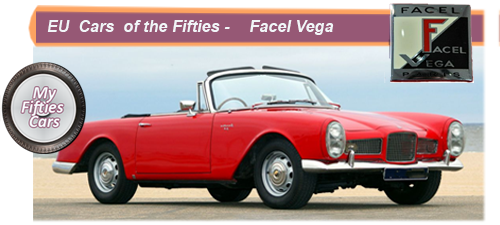 Like many of his counterparts in the burgeoning French car industry , Jean Daninos, the creator of the Facel-Vega brand, confused his role as a business manager with that of a car designer and producer.
Like many of his counterparts in the burgeoning French car industry , Jean Daninos, the creator of the Facel-Vega brand, confused his role as a business manager with that of a car designer and producer.
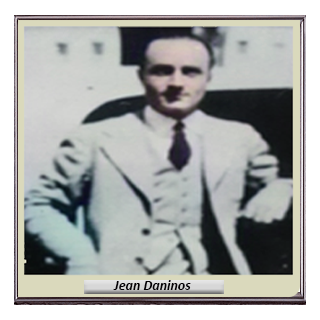 After attending the prestigious Arts et Métiers in his home city of Paris and then the Scarborough Mechanical Engineering School in England, Jean joined Citroën as a remaining there from 1928 to 1935, during which he rose to become deputy director of the bodywork division and later director in charge of special cars development, working alongside such gifted designers as Flaminio Bertoni.
In 1935, Jean Daninos left Citroen to join Morane-Saulnier a French aircraft manufacturing company where he was a consulting engineer specialising in the use of stainless steels. During his time at Morane-Saulnier, Jean took part in the development of the MS 405 fighter.
With his reputation as a designer growing, in 1937, Jean Daninos was hired as chief engineer at Bronzavia, a company that specialised in the manufacture of accessories for the aeronautical industry.
In December 1939, the company F.A.C.E.L. (Forges et Ateliers de Construction d’Eure-et-Loir) was created as a subsidiary of Bronzavia with R&D and production based in a special facility in Paris.
After attending the prestigious Arts et Métiers in his home city of Paris and then the Scarborough Mechanical Engineering School in England, Jean joined Citroën as a remaining there from 1928 to 1935, during which he rose to become deputy director of the bodywork division and later director in charge of special cars development, working alongside such gifted designers as Flaminio Bertoni.
In 1935, Jean Daninos left Citroen to join Morane-Saulnier a French aircraft manufacturing company where he was a consulting engineer specialising in the use of stainless steels. During his time at Morane-Saulnier, Jean took part in the development of the MS 405 fighter.
With his reputation as a designer growing, in 1937, Jean Daninos was hired as chief engineer at Bronzavia, a company that specialised in the manufacture of accessories for the aeronautical industry.
In December 1939, the company F.A.C.E.L. (Forges et Ateliers de Construction d’Eure-et-Loir) was created as a subsidiary of Bronzavia with R&D and production based in a special facility in Paris.
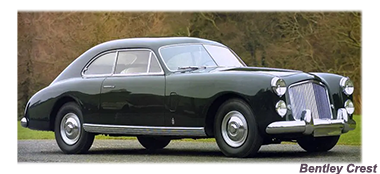 With the German invasion of France in the spring of 1940, Jean Daninos managed to escape the Germans to neutral Switzerland where he established a design office in Geneva.
In 1943, Jean Daninos moved to the United States to set up General Aircraft Equipment.
With the German invasion of France in the spring of 1940, Jean Daninos managed to escape the Germans to neutral Switzerland where he established a design office in Geneva.
In 1943, Jean Daninos moved to the United States to set up General Aircraft Equipment.
 As soon as peace broke out Jean Daninos’s sense of aesthetics took over. He is drafting a large sedan that could revive the Hispano Suiza brand.
In 1945, F.A.C.E.L. merged with Métallon, a brand that had been born in 1937 and transformed into Facel Métallon.
The new company naturally turned to the automobile industry, developed the manufacturing methods for the Dyna Panhard box in collaboration with French Aluminum, and produced more than 45,000 copies between 1946 and 1953.
In 1948, Facel Metallon inaugurated a department dedicated to luxury bodies for the manufacture of the Simca Sport (from 1949), the Ford Comet (1951) as well as models for Delahaye and Bentley.
As soon as peace broke out Jean Daninos’s sense of aesthetics took over. He is drafting a large sedan that could revive the Hispano Suiza brand.
In 1945, F.A.C.E.L. merged with Métallon, a brand that had been born in 1937 and transformed into Facel Métallon.
The new company naturally turned to the automobile industry, developed the manufacturing methods for the Dyna Panhard box in collaboration with French Aluminum, and produced more than 45,000 copies between 1946 and 1953.
In 1948, Facel Metallon inaugurated a department dedicated to luxury bodies for the manufacture of the Simca Sport (from 1949), the Ford Comet (1951) as well as models for Delahaye and Bentley.
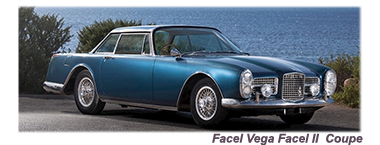 An outstanding example of Daninos’s design skills was the Bentley Cresta, a model created by renowned Italian bodybuilder Pinin Farina that was first presented at the Paris Salon of 1948.
As part of the design agreement between Facel-Metallon and Pinin Farina was the right to produce this Bentley coupé under license.
After the prototype, made in Turin, sixteen more copies were produced by Facel.
An outstanding example of Daninos’s design skills was the Bentley Cresta, a model created by renowned Italian bodybuilder Pinin Farina that was first presented at the Paris Salon of 1948.
As part of the design agreement between Facel-Metallon and Pinin Farina was the right to produce this Bentley coupé under license.
After the prototype, made in Turin, sixteen more copies were produced by Facel.
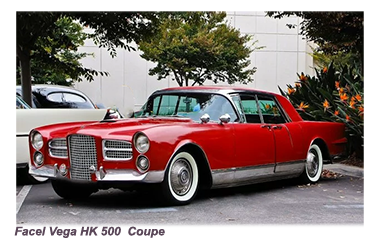 Early models were marketed under the Facel-Metallon Vega, with Facel Vega only in common use from 1956.
Nearly all of the first Vegas were exported, since domestic buyers were obliged to pay very high taxes for such a large-engined vehicle.
By the mid-Fifties, the Facel Vega had gained a strong reputation for its look and its power, especially popular in the United States, while to a lesser extent in the UK.
Early models were marketed under the Facel-Metallon Vega, with Facel Vega only in common use from 1956.
Nearly all of the first Vegas were exported, since domestic buyers were obliged to pay very high taxes for such a large-engined vehicle.
By the mid-Fifties, the Facel Vega had gained a strong reputation for its look and its power, especially popular in the United States, while to a lesser extent in the UK.
 Most Vegas cars were two-door hardtops with no centre pillar, although a few convertibles were built, always to special order.
When the Vega went into production, first of all, the FV and later the more popular HK500, were all fitted with V8 engines, supplied by Chrysler.
Early models were powered by 4.5-litre (275 cu in) DeSoto Hemi engine, with the HK 500 coming with a choice of either a DeSoto Fire Dome V8 4,940 cc Chrysler Poly V8 5,407 cc DeSoto Fire Dome V8 5,801 cc or a Chrysler Hemi V8 6,279 cc Chrysler Typhoon V8.
The transmission was either 2- or 3-speed automatic or 4-speed manual.
The Facel Vegas were fitted with suspension at the front and a live axle at the back, as in standard American practice. They were also as heavy as American cars, at about 1,800 kg (3,968 lb.) (3,968 lb.).
Performance was brisk for such a heavy car, at around 190 km/h (118 mph) , while capable of reaching a100 km/h (62 mph) in just under ten seconds.
Most Vegas cars were two-door hardtops with no centre pillar, although a few convertibles were built, always to special order.
When the Vega went into production, first of all, the FV and later the more popular HK500, were all fitted with V8 engines, supplied by Chrysler.
Early models were powered by 4.5-litre (275 cu in) DeSoto Hemi engine, with the HK 500 coming with a choice of either a DeSoto Fire Dome V8 4,940 cc Chrysler Poly V8 5,407 cc DeSoto Fire Dome V8 5,801 cc or a Chrysler Hemi V8 6,279 cc Chrysler Typhoon V8.
The transmission was either 2- or 3-speed automatic or 4-speed manual.
The Facel Vegas were fitted with suspension at the front and a live axle at the back, as in standard American practice. They were also as heavy as American cars, at about 1,800 kg (3,968 lb.) (3,968 lb.).
Performance was brisk for such a heavy car, at around 190 km/h (118 mph) , while capable of reaching a100 km/h (62 mph) in just under ten seconds.
 In the early Sixties attempting to reach a more “middle-of- the road” market in the sports car sector, Facel Vega launched the Facellia, available as either a cabriolet, 2+2 coupé, or 4-seat coupé.
At the same time, a misplaced move from Facel saw them desist from fitting American engines, instead turning to the Pont-à-Mousson company to produce a 4-cylinder 1.6 L DOHC engine specificallyly designed to be fitted in the Facelias.
Due to a major design flaw that no one at Facel picked up on, instead of the engine being fitted with four or even five bearings, used only two steel supports were fitted to support each camshaft.
This situation rapidly led to excessive flex, with attendant timing issues, causing a high rate of failure.
A team of independent engineers were brought in to investigate the problem , rapidly concluding that it to be beyond solving.
As a result of this major setback, in August 1961, Jean Daninos was forced to resign his position at Facel, despite leading the company for more than 25 years of outstanding success.
Daninos, still only in his mid-Fifties. took himself to live in the south of France, passing away at a ripe old age having withdrawn completely from the car industry that he so loved.
A former oil executive by the name of André Belin was brought in as president of the company. Belin’s first brief was to issue strict directives to replace Facellia engines free of charge without causing "difficulties” to the customers.
In the early Sixties attempting to reach a more “middle-of- the road” market in the sports car sector, Facel Vega launched the Facellia, available as either a cabriolet, 2+2 coupé, or 4-seat coupé.
At the same time, a misplaced move from Facel saw them desist from fitting American engines, instead turning to the Pont-à-Mousson company to produce a 4-cylinder 1.6 L DOHC engine specificallyly designed to be fitted in the Facelias.
Due to a major design flaw that no one at Facel picked up on, instead of the engine being fitted with four or even five bearings, used only two steel supports were fitted to support each camshaft.
This situation rapidly led to excessive flex, with attendant timing issues, causing a high rate of failure.
A team of independent engineers were brought in to investigate the problem , rapidly concluding that it to be beyond solving.
As a result of this major setback, in August 1961, Jean Daninos was forced to resign his position at Facel, despite leading the company for more than 25 years of outstanding success.
Daninos, still only in his mid-Fifties. took himself to live in the south of France, passing away at a ripe old age having withdrawn completely from the car industry that he so loved.
A former oil executive by the name of André Belin was brought in as president of the company. Belin’s first brief was to issue strict directives to replace Facellia engines free of charge without causing "difficulties” to the customers.
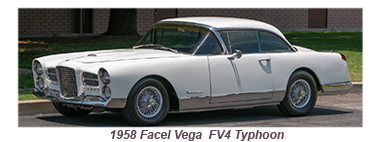 Belin later explained that his strategy was to regain the trust of the company's customers. Unfortunately, this generous gesture had little effect on restoring the company’s credibility.
The Facel III's problematic engine was swapped out for a Volvo B18, but the damage had already been done.
In 1963, production was halted and only 1100 cars were made, which was still enough to make this Facel's highest production total.
Belin later explained that his strategy was to regain the trust of the company's customers. Unfortunately, this generous gesture had little effect on restoring the company’s credibility.
The Facel III's problematic engine was swapped out for a Volvo B18, but the damage had already been done.
In 1963, production was halted and only 1100 cars were made, which was still enough to make this Facel's highest production total.
 In October 1964, Facel was forced to close its doors due to a lack of success, and the company's losses were exacerbated by fierce competition in the luxury market.
In October 1964, Facel was forced to close its doors due to a lack of success, and the company's losses were exacerbated by fierce competition in the luxury market.
Take me back to the home page
EU6

